Newborn Care | Я«фЯ«┐Я«▒Я«еЯ»ЇЯ«ц Я«ЋЯ»ЂЯ«┤Я«еЯ»ЇЯ«цЯ»ѕ Я«фЯ«░Я«ЙЯ««Я«░Я«┐Я«фЯ»ЇЯ«фЯ»Ђ | Juhin J
5 likes7,755 views
This content is exclusively for Bsc- Nursing Students...
1 of 16
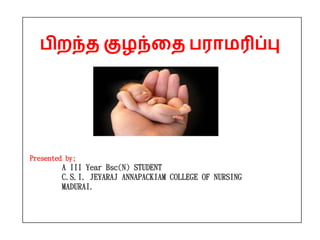
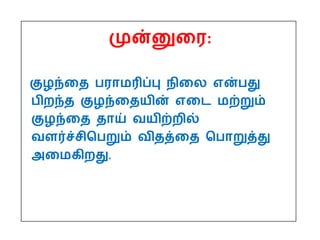
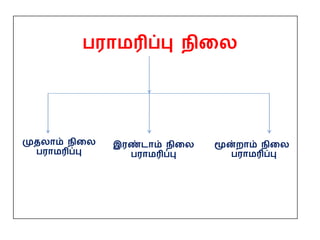
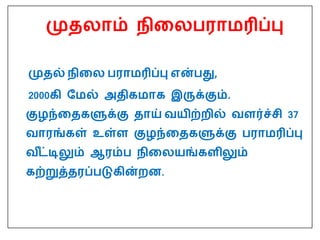
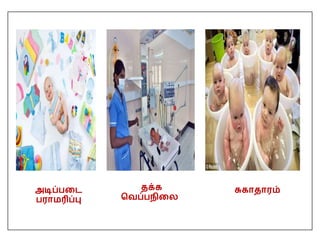
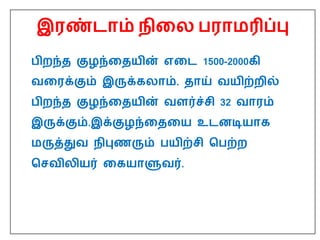



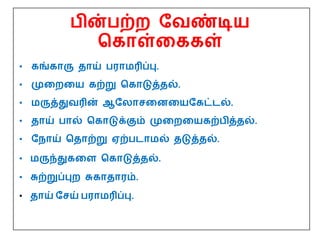
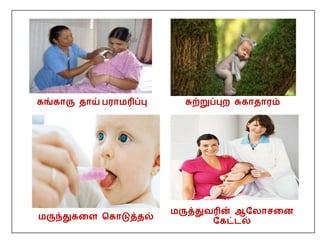
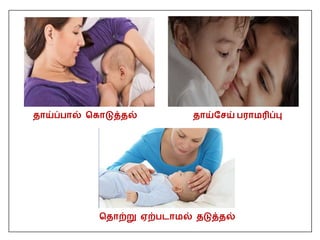

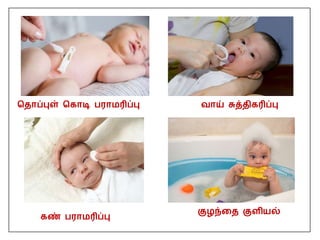

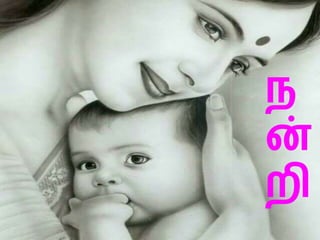
Recommended
Growth and development of all age groups | Juhin J
Growth and development of all age groups | Juhin JJuhin J
╠§
The document provides a comprehensive overview of human growth and development from birth through early childhood, outlining various reflexes, physical milestones, and developmental stages. It discusses psychosocial, psychosexual, spiritual, intellectual, and moral development across different ages, particularly emphasizing the changes in motor skills, language acquisition, and play behavior. Additionally, it highlights the importance of nurturing and securing environments that support growth and learning at each developmental stage.Antenatal Care | Я«ЋЯ«░Я»ЂЯ«цЯ»ЇЯ«цЯ«░Я«┐Я«фЯ»ЇЯ«фЯ«цЯ«▒Я»ЇЯ«ЋЯ»Ђ Я««Я»ЂЯ«ЕЯ»Ї Я««Я«▒Я»ЇЯ«▒Я»ЂЯ««Я»Ї Я«ЋЯ«░Я»ЇЯ«фЯ»ЇЯ«фЯ«ЋЯ«ЙЯ«▓ Я«ЋЯ«хЯ«ЕЯ«┐Я«фЯ»ЇЯ«фЯ»Ђ Я««Я»ЂЯ«▒Я»ѕЯ«ЋЯ«│Я»Ї |...
Antenatal Care | Я«ЋЯ«░Я»ЂЯ«цЯ»ЇЯ«цЯ«░Я«┐Я«фЯ»ЇЯ«фЯ«цЯ«▒Я»ЇЯ«ЋЯ»Ђ Я««Я»ЂЯ«ЕЯ»Ї Я««Я«▒Я»ЇЯ«▒Я»ЂЯ««Я»Ї Я«ЋЯ«░Я»ЇЯ«фЯ»ЇЯ«фЯ«ЋЯ«ЙЯ«▓ Я«ЋЯ«хЯ«ЕЯ«┐Я«фЯ»ЇЯ«фЯ»Ђ Я««Я»ЂЯ«▒Я»ѕЯ«ЋЯ«│Я»Ї |...Juhin J
╠§
This content is exclusively for Bsc- Nursing Students...Neurological assessment
Neurological assessmentShweta Sharma
╠§
A neurological assessment evaluates the nervous system, which includes the brain, spinal cord, and nerves. It focuses on identifying any abnormalities that may affect daily functioning. The assessment helps determine which parts of the neurological system are affected and the precise location of any issues. It involves taking a patient history, examining mental status, cranial nerves, motor skills, sensation, coordination, gait, and reflexes. As part of the assessment, nurses are responsible for monitoring patients, maintaining proper positioning, and assisting with any required investigations.NEUROLOGICAL ASSESSMENT
NEUROLOGICAL ASSESSMENTManikandan T
╠§
This document provides details on performing a neurological assessment, including assessing various aspects of consciousness, cranial nerves, sensation, and reflexes. It describes how to test orientation, memory, intellectual function, thought content, affect, and language. It also provides steps for examining each of the 12 cranial nerves, including smell, vision, eye movement, facial expression, hearing/balance, swallowing, shoulder shrugging, and tongue movement. Sensation tests are outlined for touch, pain, temperature, position, and vibration.Hemorrhage in children
Hemorrhage in childrenRia Saira
╠§
This document discusses hemorrhage, or bleeding. It defines hemorrhage as the loss of blood from the circulatory system, which can occur internally or externally. Hemorrhage is classified into four classes based on the percentage of lost blood volume. The causes of hemorrhage include traumatic injury and underlying medical conditions. Management of hemorrhage involves techniques like elevation, direct pressure, pressure points, and tourniquets to stop bleeding externally. Internal bleeding requires medical treatment. Life Cycle Assessment
Life Cycle Assessment AMIT BUNDELA
╠§
Life Cycle Analysis (LCA) is a technique used to evaluate the environmental impacts throughout the life cycle stages of a product, from raw material extraction to waste management. The process involves defining goals, inventory analysis, impact assessment, and interpretation, aiming to enhance sustainability and inform public policy. While LCA has advantages like comprehensive analysis and quantitative comparisons, it also has challenges such as data requirements and complexity in full assessments.National diabetes control programme
National diabetes control programmeSabeena Sasidharan
╠§
The National Diabetes Control Programme was started on a pilot basis in 1987 in some districts of Tamil Nadu, J&K, and Karnataka to prevent diabetes through identifying at-risk groups, early diagnosis and treatment, and preventing complications. However, due to lack of funds, the program was not expanded. Its objectives include prevention, early diagnosis and treatment, reducing morbidity and mortality in at-risk groups, and rehabilitation.Cardiac arrest bsc
Cardiac arrest bscBaljinder Singh
╠§
Cardiac arrest occurs when the heart suddenly stops beating effectively due to electrical abnormalities or mechanical problems, disrupting blood flow. Signs include loss of pulse and consciousness. Diagnosis involves ECG and lab tests. Treatment follows the "chain of survival" - early CPR, defibrillation if needed, advanced life support, and post-cardiac care. Nursing management focuses on restoring cardiac output and tissue perfusion through CPR, medications, fluid therapy, and monitoring for complications from the arrest and treatment.Essential newborn care for 3 rd year bsc
Essential newborn care for 3 rd year bscsindhujojo
╠§
This document discusses essential newborn care strategies to reduce newborn deaths through cost-effective interventions. It outlines key components of newborn care including immediate care at birth, ensuring warmth, breastfeeding within the first hour, identifying danger signs, treatment of problems like asphyxia and sepsis, and making plans for continued care. Specific care practices are described such as preventing infection through handwashing and cleaning, assessing the newborn's breathing and color, clamping and cutting the umbilical cord, keeping the newborn warm through skin-to-skin contact and breastfeeding. The newborn's condition should be closely observed in the first few hours.Introduction of midwifery and obstetrical nursing
Introduction of midwifery and obstetrical nursingHARSH786249
╠§
The document provides an overview of midwifery and obstetrical nursing, including its historical development in India before and after independence. It outlines key terms related to pregnancy and childbirth, the importance of trained midwives for maternal health, and contemporary trends in maternal and child health care. Additionally, it highlights the evolving role of nurses and the influence of technology and family-centered care in current practices.POSTNATAL ASSESSMENT
POSTNATAL ASSESSMENTTripti Goarya
╠§
The document discusses postpartum care, emphasizing the importance of systematic examinations and guidance for mothers in the puerperium period. It outlines various aspects of postnatal assessments using the 'bubblehe' method, covering physical, emotional, and care considerations for both mother and baby. Additionally, it addresses common myths and facts related to postpartum dietary practices, aiming to inform new mothers about optimal food choices for recovery and lactation.Current trends in obg
Current trends in obgKrupa Meet Patel
╠§
As technology has advanced, nursing care has incorporated more high-tech innovations like electronic fetal monitors, but this has reduced hands-on patient care and increased costs. Looking ahead, nurses will need knowledge of emerging technologies and there will be challenges in providing care in a highly technical world. Factors like advanced maternal age, low birth weight, and socioeconomic status can increase pregnancy risks.EXCLUSIVE BREASTFEEDING PPT.pptx
EXCLUSIVE BREASTFEEDING PPT.pptxnaveenithkrishnan
╠§
The document provides an overview of exclusive breastfeeding, outlining its definition, public health significance, and factors affecting breastfeeding practices. It emphasizes the health benefits of exclusive breastfeeding for both infants and mothers, while also discussing its challenges. The conclusion highlights the importance of breastfeeding as the optimal feeding method for infants and the need for improved adherence to recommendations for exclusive breastfeeding in the early months of life.Presentation on Baby friendly hospital initiative
Presentation on Baby friendly hospital initiativeSimran Dhiman
╠§
The presentation provides an overview of the Baby-Friendly Hospital Initiative (BFHI), which was launched in 1991 by UNICEF and WHO to promote breastfeeding. The goals of BFHI are to transform hospitals through implementing the Ten Steps to Successful Breastfeeding and end distribution of breastmilk substitutes. The Ten Steps include establishing breastfeeding policies, training staff, educating mothers, and encouraging breastfeeding within 30 minutes of birth, on demand, and without pacifiers. Hospitals must foster breastfeeding support groups prior to discharge to be Baby-Friendly certified. The document reviews the Ten Steps and medical reasons substitutes may be needed, and the role of administrators in upholding the International Code of Marketing of BreastmilkIntegrated child development services
Integrated child development servicesSoundar Rajan
╠§
The Integrated Child Development Services (ICDS) program was initiated in 1975 to provide integrated health, nutrition, and education services to children aged 0-6 years and mothers in India. The objectives of ICDS include improving nutritional status, health status, psychological development, and reducing mortality, morbidity, and malnutrition. Key services provided include nutritional and health education, growth monitoring, and iron-folate supplements. ICDS also sets nutritional and feeding norms for children of different ages. It is linked to other national programs focused on health, nutrition, employment, and food security.Nursing management of low birth weight(lbw) babies
Nursing management of low birth weight(lbw) babiesRose Vadakkut
╠§
This document provides information on the management of low birth weight babies. It defines different categories of low birth weight, describes optimal care at birth including warming and feeding practices. It outlines monitoring requirements and discusses positioning, thermal comfort, oxygen therapy, phototherapy and infection control. The document also covers nutrition, stimulation, immunization and family support needs for low birth weight infants.Baby Bath
Baby BathPooja Rani
╠§
This document provides guidance on baby bathing. It defines baby bathing as cleaning the skin of infants to promote hygiene and comfort. The objectives of baby bathing are to keep the skin clean, refresh the baby, stimulate circulation, and prevent infections while observing the baby. Types of baths include lap baths, sponge baths, and tub baths. General instructions are provided on water temperature, duration, supervision, and timing relative to feeding. A list of required articles and steps for bathing are outlined. Contraindications and aftercare are also discussed.steam inhalation ppt
steam inhalation pptKiranmayee Yadav
╠§
Steam inhalation involves inhaling warm, moist air to relieve symptoms of respiratory inflammation and congestion. It works by loosening secretions, relaxing muscles to reduce coughing, and moistening irritated airways. To perform steam inhalation, boil water and add medication like Vicks vaporub. Direct the steam into a tent made from an umbrella and sheet covering the patient, or have them sit near the boiling water. Treatment lasts 30 minutes to an hour twice a day. Burn risks and drafts should be avoided, and extra care taken with children.KANGAROO MOTHER CARE
KANGAROO MOTHER CAREMAHESWARI JAIKUMAR
╠§
Kangaroo mother care (KMC) is a technique for caring for low birth weight babies that involves continuous skin-to-skin contact between the mother and baby, exclusive breastfeeding, and early discharge from the hospital. The three main components of KMC are keeping the baby in direct skin-to-skin contact with the mother in a "kangaroo position", exclusive breastfeeding to provide "kangaroo nutrition", and early discharge from and regular follow-up after the hospital to allow for "kangaroo early discharge". KMC provides benefits to both the baby and mother such as improved physiological stability, bonding, and reduced stress for the mother.Changes trends in hospital care
Changes trends in hospital carelingampelli
╠§
This document discusses trends in hospital care for sick children. It outlines different types of facilities that provide pediatric care, such as pediatric units, neonatal intensive care units, and outpatient departments. It then examines the impact of hospitalization on children and families of different age groups. Babies experience separation anxiety and impaired bonding. Toddlers may react with protest, despair or regression. Older children's reactions include fears, worries and mental mechanisms like repression. Adolescents can feel anxiety, anger and depression. The role of the child health nurse is to provide family-centered care appropriate to each age, minimize stress, encourage self-care and involve parents to help children cope with hospitalization.Perineal care for b.sc iv year
Perineal care for b.sc iv yearanjalatchi
╠§
The presentation by Miss Anjum Bano focuses on perineal care, covering its definition, purposes, indications, contraindications, and procedural steps. It emphasizes the importance of cleanliness in preventing infections, and details the preparation needed for both the patient and environment. The conclusion notes the associations between maternal health factors and the prevalence of spontaneous perineal tears.Admission of neonate in nicu
Admission of neonate in nicujaskaranChauhan3
╠§
The document discusses the admission criteria and procedures for neonates in the Neonatal Intensive Care Unit (NICU), highlighting its purpose to manage critically ill newborns and reduce mortality and morbidity. Key points include the levels of neonatal care, reasons for NICU admission, essential equipment, and the admission process which involves collecting maternal and obstetrical histories, conducting examinations, and monitoring vital signs. The document emphasizes the importance of specialized care and continuous training for healthcare personnel involved in neonatal management.Minor disorders of newborn
Minor disorders of newbornP V GREESHMA
╠§
This document summarizes minor disorders that can occur in newborns. It defines a newborn as an infant from birth until 28 days old. It then describes and provides treatment recommendations for common minor issues newborns may experience such as stuffy nose, sticky eyes, skin rashes, oral thrush, jaundice, engorgement of the breast, vomiting, diarrhea, hiccups, sneezing, failure to pass urine or meconium, excessive crying, excessive sleepiness, caput succedaneum, umbilical granuloma, pink eye, baby acne, and genital issues. The document stresses the importance of not neglecting minor health problems in newborns.Care of child in incubator
Care of child in incubatorLivson Thomas
╠§
This document provides information on incubators and the care of infants placed in incubators. It defines an incubator as an environment used to maintain temperature and humidity for high-risk newborns. The main purposes of an incubator are to regulate temperature and humidity, provide oxygenation, allow for observation of sick infants, and isolate newborns from infection. Indications for incubator care include prematurity, low birth weight, hypothermia, sickness, and transportation between locations. The document describes the parts of an incubator and procedures for placing an infant in an incubator and providing ongoing care.Community Bag Technique
Community Bag Techniqueshamil C.B
╠§
The community bag is an essential tool for community health nurses, containing necessary medications and equipment for home visits. It is designed to facilitate effective nursing care while promoting health and preventing diseases among community members. The document outlines the composition, organization, and proper usage techniques of the community bag to ensure efficient healthcare delivery.Stomal therapy
Stomal therapyHarsh Rastogi
╠§
The document discusses stomal therapy, explaining various types of stomas like colostomy, ileostomy, urostomy, gastrostomy, and jejunostomy, which are openings created to allow the passage of stool or urine. It outlines indications for ostomy surgery, the selection of stoma pouches, and potential complications, noting that such surgeries can be temporary or permanent. The document concludes with a list of references related to medical and surgical nursing.MLHP (Mid level health provider)
MLHP (Mid level health provider)Shubham Dhamanikar
╠§
The document discusses mid-level health providers, their roles, and training. It begins by outlining the objectives of the seminar, which are to introduce mid-level providers, define them, explain their need, discuss their training, and describe their roles and responsibilities. It then provides details on mid-level providers, including their scope of practice and role in bridging gaps between communities and healthcare. The document also discusses India's Community Health Officer program and the services mid-level providers offer, such as maternal, child, and chronic disease care. It concludes by listing the roles and responsibilities of community health officers.Nursing care of a normal newborn.pptx
Nursing care of a normal newborn.pptxRajalakshmi Blesson
╠§
The document outlines the immediate and routine care needs of a neonate. Immediate care at birth includes delivering the baby on a warm towel, establishing an airway, ensuring warmth, assessment, eye care, clamping and cutting the cord, skin care, vitamin K administration, identification, and transferring the baby according to care needs. Routine care involves rooming-in, initiating feeding, observation for diseases, infection prevention, bladder and bowel care, hygiene, and parental teaching. Sick or premature babies require higher levels of neonatal intensive care.Tips to reduce alcohol intake | Psycho Education | Juhin J
Tips to reduce alcohol intake | Psycho Education | Juhin JJuhin J
╠§
Tips to reduce alcohol intake:
- Gradually reduce the number of drinks
- Use smaller glasses
- Substitute a glass of water in between alcoholic drinks
- Change triggering environment
- Change from your preferred alcoholic drink to one you do not like
- Don't stock up on alcohol
- Be realistic
- Find healthy coping mechanismDigital Addiction | Psycho Education | Juhin J
Digital Addiction | Psycho Education | Juhin JJuhin J
╠§
Digital Addiction:
---Signs & Symptoms---
- Unable to leave your house without phone
- Compelled to check the phone constantly for no particular reason
- Eating with your phone on the table
- Feeling anxious or depressed after using social media
- Obsessed over sending or recieving a text or posting a comment
- Feeling afraid of missing out
---Management---
- Start the day without mobile phone
- Turn off devices 30 minutes before bed
- Delete time setealing apps from your phone
- Turn off notifications
- Only respond to emails and texts at specific times of the dayMore Related Content
What's hot (20)
Essential newborn care for 3 rd year bsc
Essential newborn care for 3 rd year bscsindhujojo
╠§
This document discusses essential newborn care strategies to reduce newborn deaths through cost-effective interventions. It outlines key components of newborn care including immediate care at birth, ensuring warmth, breastfeeding within the first hour, identifying danger signs, treatment of problems like asphyxia and sepsis, and making plans for continued care. Specific care practices are described such as preventing infection through handwashing and cleaning, assessing the newborn's breathing and color, clamping and cutting the umbilical cord, keeping the newborn warm through skin-to-skin contact and breastfeeding. The newborn's condition should be closely observed in the first few hours.Introduction of midwifery and obstetrical nursing
Introduction of midwifery and obstetrical nursingHARSH786249
╠§
The document provides an overview of midwifery and obstetrical nursing, including its historical development in India before and after independence. It outlines key terms related to pregnancy and childbirth, the importance of trained midwives for maternal health, and contemporary trends in maternal and child health care. Additionally, it highlights the evolving role of nurses and the influence of technology and family-centered care in current practices.POSTNATAL ASSESSMENT
POSTNATAL ASSESSMENTTripti Goarya
╠§
The document discusses postpartum care, emphasizing the importance of systematic examinations and guidance for mothers in the puerperium period. It outlines various aspects of postnatal assessments using the 'bubblehe' method, covering physical, emotional, and care considerations for both mother and baby. Additionally, it addresses common myths and facts related to postpartum dietary practices, aiming to inform new mothers about optimal food choices for recovery and lactation.Current trends in obg
Current trends in obgKrupa Meet Patel
╠§
As technology has advanced, nursing care has incorporated more high-tech innovations like electronic fetal monitors, but this has reduced hands-on patient care and increased costs. Looking ahead, nurses will need knowledge of emerging technologies and there will be challenges in providing care in a highly technical world. Factors like advanced maternal age, low birth weight, and socioeconomic status can increase pregnancy risks.EXCLUSIVE BREASTFEEDING PPT.pptx
EXCLUSIVE BREASTFEEDING PPT.pptxnaveenithkrishnan
╠§
The document provides an overview of exclusive breastfeeding, outlining its definition, public health significance, and factors affecting breastfeeding practices. It emphasizes the health benefits of exclusive breastfeeding for both infants and mothers, while also discussing its challenges. The conclusion highlights the importance of breastfeeding as the optimal feeding method for infants and the need for improved adherence to recommendations for exclusive breastfeeding in the early months of life.Presentation on Baby friendly hospital initiative
Presentation on Baby friendly hospital initiativeSimran Dhiman
╠§
The presentation provides an overview of the Baby-Friendly Hospital Initiative (BFHI), which was launched in 1991 by UNICEF and WHO to promote breastfeeding. The goals of BFHI are to transform hospitals through implementing the Ten Steps to Successful Breastfeeding and end distribution of breastmilk substitutes. The Ten Steps include establishing breastfeeding policies, training staff, educating mothers, and encouraging breastfeeding within 30 minutes of birth, on demand, and without pacifiers. Hospitals must foster breastfeeding support groups prior to discharge to be Baby-Friendly certified. The document reviews the Ten Steps and medical reasons substitutes may be needed, and the role of administrators in upholding the International Code of Marketing of BreastmilkIntegrated child development services
Integrated child development servicesSoundar Rajan
╠§
The Integrated Child Development Services (ICDS) program was initiated in 1975 to provide integrated health, nutrition, and education services to children aged 0-6 years and mothers in India. The objectives of ICDS include improving nutritional status, health status, psychological development, and reducing mortality, morbidity, and malnutrition. Key services provided include nutritional and health education, growth monitoring, and iron-folate supplements. ICDS also sets nutritional and feeding norms for children of different ages. It is linked to other national programs focused on health, nutrition, employment, and food security.Nursing management of low birth weight(lbw) babies
Nursing management of low birth weight(lbw) babiesRose Vadakkut
╠§
This document provides information on the management of low birth weight babies. It defines different categories of low birth weight, describes optimal care at birth including warming and feeding practices. It outlines monitoring requirements and discusses positioning, thermal comfort, oxygen therapy, phototherapy and infection control. The document also covers nutrition, stimulation, immunization and family support needs for low birth weight infants.Baby Bath
Baby BathPooja Rani
╠§
This document provides guidance on baby bathing. It defines baby bathing as cleaning the skin of infants to promote hygiene and comfort. The objectives of baby bathing are to keep the skin clean, refresh the baby, stimulate circulation, and prevent infections while observing the baby. Types of baths include lap baths, sponge baths, and tub baths. General instructions are provided on water temperature, duration, supervision, and timing relative to feeding. A list of required articles and steps for bathing are outlined. Contraindications and aftercare are also discussed.steam inhalation ppt
steam inhalation pptKiranmayee Yadav
╠§
Steam inhalation involves inhaling warm, moist air to relieve symptoms of respiratory inflammation and congestion. It works by loosening secretions, relaxing muscles to reduce coughing, and moistening irritated airways. To perform steam inhalation, boil water and add medication like Vicks vaporub. Direct the steam into a tent made from an umbrella and sheet covering the patient, or have them sit near the boiling water. Treatment lasts 30 minutes to an hour twice a day. Burn risks and drafts should be avoided, and extra care taken with children.KANGAROO MOTHER CARE
KANGAROO MOTHER CAREMAHESWARI JAIKUMAR
╠§
Kangaroo mother care (KMC) is a technique for caring for low birth weight babies that involves continuous skin-to-skin contact between the mother and baby, exclusive breastfeeding, and early discharge from the hospital. The three main components of KMC are keeping the baby in direct skin-to-skin contact with the mother in a "kangaroo position", exclusive breastfeeding to provide "kangaroo nutrition", and early discharge from and regular follow-up after the hospital to allow for "kangaroo early discharge". KMC provides benefits to both the baby and mother such as improved physiological stability, bonding, and reduced stress for the mother.Changes trends in hospital care
Changes trends in hospital carelingampelli
╠§
This document discusses trends in hospital care for sick children. It outlines different types of facilities that provide pediatric care, such as pediatric units, neonatal intensive care units, and outpatient departments. It then examines the impact of hospitalization on children and families of different age groups. Babies experience separation anxiety and impaired bonding. Toddlers may react with protest, despair or regression. Older children's reactions include fears, worries and mental mechanisms like repression. Adolescents can feel anxiety, anger and depression. The role of the child health nurse is to provide family-centered care appropriate to each age, minimize stress, encourage self-care and involve parents to help children cope with hospitalization.Perineal care for b.sc iv year
Perineal care for b.sc iv yearanjalatchi
╠§
The presentation by Miss Anjum Bano focuses on perineal care, covering its definition, purposes, indications, contraindications, and procedural steps. It emphasizes the importance of cleanliness in preventing infections, and details the preparation needed for both the patient and environment. The conclusion notes the associations between maternal health factors and the prevalence of spontaneous perineal tears.Admission of neonate in nicu
Admission of neonate in nicujaskaranChauhan3
╠§
The document discusses the admission criteria and procedures for neonates in the Neonatal Intensive Care Unit (NICU), highlighting its purpose to manage critically ill newborns and reduce mortality and morbidity. Key points include the levels of neonatal care, reasons for NICU admission, essential equipment, and the admission process which involves collecting maternal and obstetrical histories, conducting examinations, and monitoring vital signs. The document emphasizes the importance of specialized care and continuous training for healthcare personnel involved in neonatal management.Minor disorders of newborn
Minor disorders of newbornP V GREESHMA
╠§
This document summarizes minor disorders that can occur in newborns. It defines a newborn as an infant from birth until 28 days old. It then describes and provides treatment recommendations for common minor issues newborns may experience such as stuffy nose, sticky eyes, skin rashes, oral thrush, jaundice, engorgement of the breast, vomiting, diarrhea, hiccups, sneezing, failure to pass urine or meconium, excessive crying, excessive sleepiness, caput succedaneum, umbilical granuloma, pink eye, baby acne, and genital issues. The document stresses the importance of not neglecting minor health problems in newborns.Care of child in incubator
Care of child in incubatorLivson Thomas
╠§
This document provides information on incubators and the care of infants placed in incubators. It defines an incubator as an environment used to maintain temperature and humidity for high-risk newborns. The main purposes of an incubator are to regulate temperature and humidity, provide oxygenation, allow for observation of sick infants, and isolate newborns from infection. Indications for incubator care include prematurity, low birth weight, hypothermia, sickness, and transportation between locations. The document describes the parts of an incubator and procedures for placing an infant in an incubator and providing ongoing care.Community Bag Technique
Community Bag Techniqueshamil C.B
╠§
The community bag is an essential tool for community health nurses, containing necessary medications and equipment for home visits. It is designed to facilitate effective nursing care while promoting health and preventing diseases among community members. The document outlines the composition, organization, and proper usage techniques of the community bag to ensure efficient healthcare delivery.Stomal therapy
Stomal therapyHarsh Rastogi
╠§
The document discusses stomal therapy, explaining various types of stomas like colostomy, ileostomy, urostomy, gastrostomy, and jejunostomy, which are openings created to allow the passage of stool or urine. It outlines indications for ostomy surgery, the selection of stoma pouches, and potential complications, noting that such surgeries can be temporary or permanent. The document concludes with a list of references related to medical and surgical nursing.MLHP (Mid level health provider)
MLHP (Mid level health provider)Shubham Dhamanikar
╠§
The document discusses mid-level health providers, their roles, and training. It begins by outlining the objectives of the seminar, which are to introduce mid-level providers, define them, explain their need, discuss their training, and describe their roles and responsibilities. It then provides details on mid-level providers, including their scope of practice and role in bridging gaps between communities and healthcare. The document also discusses India's Community Health Officer program and the services mid-level providers offer, such as maternal, child, and chronic disease care. It concludes by listing the roles and responsibilities of community health officers.Nursing care of a normal newborn.pptx
Nursing care of a normal newborn.pptxRajalakshmi Blesson
╠§
The document outlines the immediate and routine care needs of a neonate. Immediate care at birth includes delivering the baby on a warm towel, establishing an airway, ensuring warmth, assessment, eye care, clamping and cutting the cord, skin care, vitamin K administration, identification, and transferring the baby according to care needs. Routine care involves rooming-in, initiating feeding, observation for diseases, infection prevention, bladder and bowel care, hygiene, and parental teaching. Sick or premature babies require higher levels of neonatal intensive care.More from Juhin J (20)
Tips to reduce alcohol intake | Psycho Education | Juhin J
Tips to reduce alcohol intake | Psycho Education | Juhin JJuhin J
╠§
Tips to reduce alcohol intake:
- Gradually reduce the number of drinks
- Use smaller glasses
- Substitute a glass of water in between alcoholic drinks
- Change triggering environment
- Change from your preferred alcoholic drink to one you do not like
- Don't stock up on alcohol
- Be realistic
- Find healthy coping mechanismDigital Addiction | Psycho Education | Juhin J
Digital Addiction | Psycho Education | Juhin JJuhin J
╠§
Digital Addiction:
---Signs & Symptoms---
- Unable to leave your house without phone
- Compelled to check the phone constantly for no particular reason
- Eating with your phone on the table
- Feeling anxious or depressed after using social media
- Obsessed over sending or recieving a text or posting a comment
- Feeling afraid of missing out
---Management---
- Start the day without mobile phone
- Turn off devices 30 minutes before bed
- Delete time setealing apps from your phone
- Turn off notifications
- Only respond to emails and texts at specific times of the dayStress Management | Psycho Education | Juhin J
Stress Management | Psycho Education | Juhin JJuhin J
╠§
Stress Management:
- Get enough sleep (6-8 hours)
- Be active
- Engage in meditation and yoga
- Eat well
- Take a break
- Talk to someone
- Practice deep breathing
Tips to improve Sleep Quality | Psycho Education | Juhin J
Tips to improve Sleep Quality | Psycho Education | Juhin JJuhin J
╠§
Tips to improve Sleep Quality:
- Establish a regular bedtime and waking time
- Do regular exercise
- Use comfortable bed
- Make sure your bedroom is quiet, dark with good ventilation
- Switch off your electronic devices 30-60 minutes before bed
- Avoid taking heavy foods before sleep
- Reduce intake of water before bed
- Avoid coffee, alcohol & nicotine intake
Warning Signs of Mental Illness | Psycho education | Juhin J
Warning Signs of Mental Illness | Psycho education | Juhin JJuhin J
╠§
Warning Signs of Mental Illness:
- Excessive sadness & anxiety lasting more than 2 weeks
- Sleeping or eating more/less than usual
- Inability to perform daily tasks
- Harming self
- Increased use of alcohol or other substances
- Unusual mood changes
- Decreased performance
- Believing things that aren't real
Rights of Special Groups | Constitution of Indian | Juhin J
Rights of Special Groups | Constitution of Indian | Juhin JJuhin J
╠§
The document outlines the rights of various special groups, including children, women, HIV/AIDS patients, the handicapped, the aged, and the mentally ill. It details fundamental rights as defined by the Constitution of India, focusing on legal entitlements and protections against discrimination and exploitation. Additionally, it identifies barriers to accessing these rights, such as poverty and social inequality.Continuing Nursing Education- CNE | Nursing Education | Juhin J
Continuing Nursing Education- CNE | Nursing Education | Juhin JJuhin J
╠§
The document outlines the objectives and definitions of Continuing Nursing Education (CNE), emphasizing its importance for the personal and professional growth of nurses. It covers features, functions, principles, and various types of CNE, including formal, informal, experiential, and self-directed learning. Additionally, it highlights the role of CNE in developing competent nurse practitioners and enhancing nursing practice through updated knowledge and skills.Socioeconomic Status Scale | Nursing Education | Juhin J
Socioeconomic Status Scale | Nursing Education | Juhin JJuhin J
╠§
The document provides an overview of socioeconomic status (SES), its definition, scale, and its influence on health outcomes. It details various SES classification scales, including Prasad, Udai Pareek, Kuppuswamy, and others, highlighting their methodologies, advantages, and limitations. Additionally, it discusses the importance of understanding poverty lines and the impact of socioeconomic factors on health and well-being.Alternative Systems of Medicine in Mental Health | AYUSH | CAM | Juhin J
Alternative Systems of Medicine in Mental Health | AYUSH | CAM | Juhin JJuhin J
╠§
The document provides a comprehensive overview of alternative medicine systems in mental health, including classification, principles, and specific therapies such as herbal medicine, unani, siddha, homeopathy, acupuncture, and acupressure. It emphasizes the interconnectedness of mind, body, and spirit in healing, and discusses the role of nurses in integrating these alternative approaches into patient care. Limitations and potential side effects of these therapies are also highlighted, along with the necessity for nurses to be knowledgeable in order to guide patients appropriately.Disorders of Thought and Perception | Mental Health & Psychiatric Nursing | J...
Disorders of Thought and Perception | Mental Health & Psychiatric Nursing | J...Juhin J
╠§
The document outlines disorders of thought and perception, focusing on defining and classifying thought and perception disorders. Thought disorders lead to disorganized thinking and abnormal expression, while perception disorders affect the understanding of sensory data. It includes classifications for both types of disorders and lists references for further reading.Impulse Control Disorder | Psychiatric Nursing | Juhin J
Impulse Control Disorder | Psychiatric Nursing | Juhin JJuhin J
╠§
The document provides a comprehensive overview of impulse control disorders, including definitions, classifications, epidemiology, and treatment options for conditions such as intermittent explosive disorder, kleptomania, pyromania, and trichotillomania. Each disorder is discussed in terms of its clinical manifestations, diagnostic criteria, etiology, course, and management strategies. The document also highlights the nursing process for addressing ineffective coping and impulse control, emphasizing therapeutic interventions.Personality Disorders | Psychiatric Nursing | Juhin J
Personality Disorders | Psychiatric Nursing | Juhin JJuhin J
╠§
The document outlines the definitions, epidemiology, etiology, risk factors, classification, clinical manifestations, diagnostic evaluations, and management of personality disorders. It emphasizes the complexity of personality traits and the varied approaches needed for effective treatment, including both pharmacological and non-pharmacological methods. Additionally, it discusses nursing management strategies for supporting patients with personality disorders.Histrionic, Narcissistic & Avoidance Personality Disorder | Psychiatric Nursi...
Histrionic, Narcissistic & Avoidance Personality Disorder | Psychiatric Nursi...Juhin J
╠§
The document discusses personality and personality disorders, focusing on histrionic, narcissistic, and avoidant personality disorders, including their definitions, risk factors, classifications, and management strategies. It provides insights into the clinical manifestations, epidemiology, comorbidities, and nursing management related to these disorders. Additionally, it includes results from studies on job fit and the influence of narcissism on sexual coercion among young adult women.SLEEP DISORDERS | Psychiatric Nursing | Juhin J
SLEEP DISORDERS | Psychiatric Nursing | Juhin JJuhin J
╠§
The document provides an overview of sleep, including its definitions, processes, stages, functions, and disorders. It outlines the epidemiology of sleep disorders in the Indian population and classifies sleep disorders into categories such as primary sleep disorders, psychiatric-related disorders, and substance-induced disorders. Additionally, it discusses nursing processes and interventions for managing sleep disorders.Personality Disorders | Psychiatric Nursing | Juhin J
Personality Disorders | Psychiatric Nursing | Juhin JJuhin J
╠§
The document discusses personality disorders, defining them as enduring patterns of behavior and inner experience that deviate from cultural norms. It covers key topics such as epidemiology, etiology, risk factors, classification, clinical manifestations, diagnostic evaluation, and management strategies, including both pharmacological and non-pharmacological approaches. Additionally, it outlines nursing management techniques for addressing the diverse needs of patients with personality disorders.Obsessive Compulsive Disorder | Psychiatric Nursing | Juhin J
Obsessive Compulsive Disorder | Psychiatric Nursing | Juhin J Juhin J
╠§
This document outlines the essential aspects of Obsessive-Compulsive Disorder (OCD), including its definition, epidemiology, clinical features, and management strategies. It highlights the chronic nature of OCD, its impact on individuals, and the various treatment options available, both pharmacological and non-pharmacological. The document also discusses relevant studies that explore the relationship between OCD and other disorders, as well as the influence of family dynamics on patient experiences.Hallucinogen Use Disorder | Substance Abuse | Psychiatric Nursing | Juhin J
Hallucinogen Use Disorder | Substance Abuse | Psychiatric Nursing | Juhin JJuhin J
╠§
Hallucinogen use disorder involves substances that distort reality and induce hallucinations, historically used in ceremonies for over 7,000 years. The document discusses various hallucinogens, their usage patterns, physiological and psychological effects, and treatment guidelines, including nursing management strategies and preventive measures. In India, 0.12% of the population reported hallucinogen use, highlighting the importance of education and targeted interventions to address substance abuse.Opioid Use Disorder | Substance Abuse | Psychiatric Nursing | Juhin J
Opioid Use Disorder | Substance Abuse | Psychiatric Nursing | Juhin JJuhin J
╠§
The document provides an overview of opioid use disorder, its historical context, substance profiles, patterns of use, and management strategies. It highlights the prevalence of opioid use in India, the effects of opioids on the body, symptoms of intoxication and withdrawal, and outlines treatment approaches including pharmacotherapy and psychosocial support. Additionally, it emphasizes the importance of prevention, rehabilitation, and the need for a multi-disciplinary approach in managing opioid-related issues.Inhalant Use Disorder | Substance Abuse | Psychiatric Nursing | Juhin J
Inhalant Use Disorder | Substance Abuse | Psychiatric Nursing | Juhin JJuhin J
╠§
Inhalant use disorder arises from inhaling substances like fuels and solvents, leading to euphoria and impaired judgment, primarily affecting youths aged 12-17. As of 2019, around 0.70% of Indians aged 10-75 use inhalants, with a significant need for treatment, particularly in states like Uttar Pradesh. Treatment includes managing symptoms and promoting abstinence, with prevention strategies focused on education and socio-economic improvements.Delirium & Delirum Tremens | Psychiatric Nursing | Juhin J
Delirium & Delirum Tremens | Psychiatric Nursing | Juhin JJuhin J
╠§
The document provides a comprehensive overview of delirium, including its definition, incidence, prevalence, etiology, clinical manifestations, and management strategies. Delirium is characterized by a rapid disturbance of consciousness and cognition, commonly affecting elderly patients and hospital inpatients. Additionally, it covers delirium tremens, a severe condition related to alcohol withdrawal, detailing its causes, symptoms, and treatment options.Newborn Care | Я«фЯ«┐Я«▒Я«еЯ»ЇЯ«ц Я«ЋЯ»ЂЯ«┤Я«еЯ»ЇЯ«цЯ»ѕ Я«фЯ«░Я«ЙЯ««Я«░Я«┐Я«фЯ»ЇЯ«фЯ»Ђ | Juhin J
- 1. Я«фЯ«┐Я«▒Я«еЯ»ЇЯ«ц Я«ЋЯ»ЂЯ«┤Я«еЯ»ЇЯ«цЯ«ц Я«фЯ«░Я«ЙЯ««Я«░Я«┐Я«фЯ»ЇЯ«фЯ»Ђ Presented by; A III Year Bsc(N) STUDENT C.S.I. JEYARAJ ANNAPACKIAM COLLEGE OF NURSING MADURAI.
- 2. Я««Я»ЂЯ«ЕЯ»ЇЯ«ЕЯ»ЂЯ«цЯ«░: Я«ЋЯ»ЂЯ«┤Я«еЯ»ЇЯ«цЯ«ц Я«фЯ«░Я«ЙЯ««Я«░Я«┐Я«фЯ»ЇЯ«фЯ»Ђ Я«еЯ«┐Я«цЯ»ѕ Я«јЯ«ЕЯ»ЇЯ«фЯ«цЯ»Ђ Я«фЯ«┐Я«▒Я«еЯ»ЇЯ«ц Я«ЋЯ»ЂЯ«┤Я«еЯ»ЇЯ«цЯ«цЯ«»Я«┐Я«ЕЯ»Ї Я«јЯ«цЯ»ѕ Я««Я«▒Я»ЇЯ«▒Я»ЂЯ««Я»Ї Я«ЋЯ»ЂЯ«┤Я«еЯ»ЇЯ«цЯ«ц Я«цЯ«ЙЯ«»Я»Ї Я«хЯ«»Я«┐Я«▒Я»ЇЯ«▒Я«┐Я«▓Я»Ї Я«хЯ«│Я«░Я»ЇЯ«џЯ»ЇЯ«џЯ«┐Я«фЯ«фЯ«▒Я»ЂЯ««Я»Ї Я«хЯ«┐Я«цЯ«цЯ»ЇЯ«цЯ«ц Я«фЯ«фЯ«ЙЯ«▒Я»ЂЯ«цЯ»ЇЯ«цЯ»Ђ Я«ЁЯ«цЯ««Я«ЋЯ«┐Я«▒Я«цЯ»Ђ.
- 3. Я«фЯ«░Я«ЙЯ««Я«░Я«┐Я«фЯ»ЇЯ«фЯ»Ђ Я«еЯ«┐Я«цЯ»ѕ Я««Я»ЂЯ«цЯ»ѕЯ«ЙЯ««Я»Ї Я«еЯ«┐Я«цЯ»ѕ Я«фЯ«░Я«ЙЯ««Я«░Я«┐Я«фЯ»ЇЯ«фЯ»Ђ Я«ЄЯ«░Я«БЯ»ЇЯ»ѕЯ«ЙЯ««Я»Ї Я«еЯ«┐Я«цЯ»ѕ Я«фЯ«░Я«ЙЯ««Я«░Я«┐Я«фЯ»ЇЯ«фЯ»Ђ Я««Я»ѓЯ«ЕЯ»ЇЯ«▒Я«ЙЯ««Я»Ї Я«еЯ«┐Я«цЯ»ѕ Я«фЯ«░Я«ЙЯ««Я«░Я«┐Я«фЯ»ЇЯ«фЯ»Ђ
- 4. Я««Я»ЂЯ«цЯ»ѕЯ«ЙЯ««Я»Ї Я«еЯ«┐Я«цЯ»ѕЯ«фЯ«░Я«ЙЯ««Я«░Я«┐Я«фЯ»ЇЯ«фЯ»Ђ Я««Я»ЂЯ«цЯ«▓Я»Ї Я«еЯ«┐Я«цЯ»ѕ Я«фЯ«░Я«ЙЯ««Я«░Я«┐Я«фЯ»ЇЯ«фЯ»Ђ Я«јЯ«ЕЯ»ЇЯ«фЯ«цЯ»Ђ, 2000Я«ЋЯ«┐ Я««Я««Я«▓Я»Ї Я«ЁЯ«цЯ«┐Я«ЋЯ««Я«ЙЯ«Ћ Я«ЄЯ«░Я»ЂЯ«ЋЯ»ЇЯ«ЋЯ»ЂЯ««Я»Ї. Я«ЋЯ»ЂЯ«┤Я«еЯ»ЇЯ«цЯ«цЯ«ЋЯ«│Я»ЂЯ«ЋЯ»ЇЯ«ЋЯ»Ђ Я«цЯ«ЙЯ«»Я»Ї Я«хЯ«»Я«┐Я«▒Я»ЇЯ«▒Я«┐Я«▓Я»Ї Я«хЯ«│Я«░Я»ЇЯ«џЯ»ЇЯ«џЯ«┐ 37 Я«хЯ«ЙЯ«░Я«ЎЯ»ЇЯ«ЋЯ«│Я»Ї Я«ЅЯ«│Я»ЇЯ«│ Я«ЋЯ»ЂЯ«┤Я«еЯ»ЇЯ«цЯ«цЯ«ЋЯ«│Я»ЂЯ«ЋЯ»ЇЯ«ЋЯ»Ђ Я«фЯ«░Я«ЙЯ««Я«░Я«┐Я«фЯ»ЇЯ«фЯ»Ђ Я«х Я»ђЯ«ЪЯ»ЇЯ«ЪЯ«┐Я«▓Я»ЂЯ««Я»Ї Я«єЯ«░Я««Я»ЇЯ«ф Я«еЯ«┐Я«цЯ»ѕЯ«»Я«ЎЯ»ЇЯ«ЋЯ«│Я«┐Я«▓Я»ЂЯ««Я»Ї Я«ЋЯ«▒Я»ЇЯ«▒Я»ЂЯ«цЯ»ЇЯ«цЯ«░Я«фЯ»ЇЯ«фЯ«ЪЯ»ЂЯ«ЋЯ«┐Я«ЕЯ»ЇЯ«▒Я«Е.
- 6. Я«фЯ«┐Я«▒Я«еЯ»ЇЯ«ц Я«ЋЯ»ЂЯ«┤Я«еЯ»ЇЯ«цЯ«цЯ«»Я«┐Я«ЕЯ»Ї Я«јЯ«цЯ»ѕ 1500-2000Я«ЋЯ«┐ Я«хЯ«цЯ«░Я«ЋЯ»ЇЯ«ЋЯ»ЂЯ««Я»Ї Я«ЄЯ«░Я»ЂЯ«ЋЯ»ЇЯ«ЋЯ»ѕЯ«ЙЯ««Я»Ї. Я«цЯ«ЙЯ«»Я»Ї Я«хЯ«»Я«┐Я«▒Я»ЇЯ«▒Я«┐Я«▓Я»Ї Я«фЯ«┐Я«▒Я«еЯ»ЇЯ«ц Я«ЋЯ»ЂЯ«┤Я«еЯ»ЇЯ«цЯ«цЯ«»Я«┐Я«ЕЯ»Ї Я«хЯ«│Я«░Я»ЇЯ«џЯ»ЇЯ«џЯ«┐ 32 Я«хЯ«ЙЯ«░Я««Я»Ї Я«ЄЯ«░Я»ЂЯ«ЋЯ»ЇЯ«ЋЯ»ЂЯ««Я»Ї.Я«ЄЯ«ЋЯ»ЇЯ«ЋЯ»ЂЯ«┤Я«еЯ»ЇЯ«цЯ«цЯ«цЯ«» Я«ЅЯ»ѕЯ«ЕЯ«ЪЯ«┐Я«»Я«ЙЯ«Ћ Я««Я«░Я»ЂЯ«цЯ»ЇЯ«цЯ»ЂЯ«х Я«еЯ«┐Я«фЯ»ЂЯ«БЯ«░Я»ЂЯ««Я»Ї Я«фЯ«»Я«┐Я«▒Я»ЇЯ«џЯ«┐ Я«фЯ«фЯ«▒Я»ЇЯ«▒ Я«фЯ«џЯ«хЯ«┐Я»ѕЯ«┐Я«»Я«░Я»Ї Я«цЯ«ЋЯ«»Я«ЙЯ«│Я»ЂЯ«хЯ«░Я»Ї. Я«ЄЯ«░Я«БЯ»ЇЯ»ѕЯ«ЙЯ««Я»Ї Я«еЯ«┐Я«цЯ»ѕ Я«фЯ«░Я«ЙЯ««Я«░Я«┐Я«фЯ»ЇЯ«фЯ»Ђ
- 7. Я«фЯ«хЯ«фЯ»ЇЯ«фЯ«ЋЯ»ЇЯ«ЋЯ«░Я»ЂЯ«хЯ«┐ Я«цЯ«┐Я«░Я«х Я«ЅЯ«БЯ«хЯ»Ђ Я«фЯ«џЯ«▓Я»ЂЯ«цЯ»ЇЯ«цЯ»ЂЯ«цЯ«▓Я»Ї Я«фЯ«хЯ«фЯ»ЇЯ«ф Я«еЯ«┐Я«цЯ»ѕ Я«џЯ«ЙЯ«░Я»ЇЯ«еЯ»ЇЯ«ц Я«џЯ»ЂЯ«▒Я»ЇЯ«▒Я»ЂЯ«џЯ»ѓЯ«┤Я«▓Я»Ї Я«еЯ«░Я««Я»ЇЯ«фЯ»Ђ Я«хЯ«┤Я«┐Я«»Я«ЙЯ«Ћ Я««Я«░Я»ЂЯ«еЯ»ЇЯ«цЯ»Ђ Я«фЯ«џЯ«▓Я»ЂЯ«цЯ»ЇЯ«цЯ»ЂЯ«цЯ«▓Я»Ї
- 8. Я««Я»ѓЯ«ЕЯ»ЇЯ«▒Я«ЙЯ««Я»Ї Я«еЯ«┐Я«цЯ»ѕ Я«фЯ«░Я«ЙЯ««Я«░Я«┐Я«фЯ»ЇЯ«фЯ»Ђ Я«ЄЯ«ЋЯ»ЇЯ«ЋЯ»ЂЯ«┤Я«еЯ»ЇЯ«цЯ«цЯ«»Я«┐Я«ЕЯ»Ї Я«јЯ«цЯ»ѕ 1200Я«ЋЯ«┐ Я«ЋЯ»ЂЯ«цЯ«▒Я«хЯ«ЙЯ«Ћ Я«ЋЯ«ЙЯ«БЯ«фЯ»ЇЯ«фЯ«ЪЯ»ЂЯ««Я»Ї.Я««Я««Я«▓Я»ЂЯ««Я»Ї Я«цЯ«ЙЯ«»Я»Ї Я«хЯ«»Я«┐Я«▒Я»ЇЯ«▒Я«┐Я«▓Я»Ї Я«џЯ«┐Я«џЯ»Ђ Я«хЯ«│Я«░Я»ЇЯ«џЯ»ЇЯ«џЯ«┐ 32 Я«хЯ«ЙЯ«░Я«ЎЯ»ЇЯ«ЋЯ«│Я»Ї Я«ЄЯ«ЋЯ»ЇЯ«ЋЯ»ЂЯ«┤Я«еЯ»ЇЯ«цЯ«цЯ«ЋЯ«│Я»Ї Я«цЯ»ђЯ«хЯ«┐Я«░ Я«џЯ«┐Я«ЋЯ«┐Я«џЯ»ЇЯ«цЯ«џ Я«фЯ«┐Я«░Я«┐Я«хЯ«┐Я«▓Я»Ї Я«цЯ«хЯ«цЯ»ЇЯ«цЯ»Ђ Я«фЯ«░Я«ЙЯ««Я«░Я«┐Я«ЋЯ»ЇЯ«ЋЯ«фЯ»ЇЯ«фЯ«ЪЯ»ЂЯ«хЯ«░Я»Ї Я««Я««Я«▓Я»ЂЯ««Я»Ї Я«фЯ«џЯ«»Я«▒Я»ЇЯ«цЯ«Ћ Я«џЯ»ЂЯ«хЯ«ЙЯ«џЯ««Я»Ї ,Я«еЯ«░Я««Я»ЇЯ«фЯ»Ђ Я«хЯ«┤Я«┐Я«»Я«ЙЯ«Ћ Я««Я«░Я»ЂЯ«еЯ»ЇЯ«цЯ»Ђ Я«фЯ«џЯ«▓Я»ЂЯ«цЯ»ЇЯ«цЯ»ЂЯ«цЯ«▓Я»Ї Я«ЋЯ»ЂЯ«цЯ«▒Я«еЯ»ЇЯ«цЯ«цЯ»Ђ 3-5% Я«ЋЯ»ЂЯ«┤Я«еЯ»ЇЯ«цЯ«ц Я«еЯ«┐Я«фЯ»ЂЯ«БЯ«░Я»Ї Я««Я«▒Я»ЇЯ«▒Я»ЂЯ««Я»Ї Я«фЯ«»Я«┐Я«▒Я»ЇЯ«џЯ«┐ Я«фЯ«фЯ«▒Я»ЇЯ«▒ Я«фЯ«џЯ«хЯ«┐Я»ѕЯ«┐Я«»Я«░Я»Ї Я«ЋЯ«БЯ»ЇЯ«ЋЯ«ЙЯ«БЯ«┐Я«фЯ»ЇЯ«фЯ«░Я»Ї.
- 9. Я«џЯ»ЂЯ«хЯ«ЙЯ«џЯ««Я»Ї Я«фЯ«џЯ«»Я«▒Я»ЇЯ«цЯ«Ћ Я«џЯ»ЂЯ«хЯ«ЙЯ«џЯ««Я»Ї Я«еЯ«░Я««Я»ЇЯ«фЯ»Ђ Я«хЯ«┤Я«┐Я«»Я«ЙЯ«Ћ Я««Я«░Я»ЂЯ«еЯ»ЇЯ«цЯ»Ђ Я«фЯ«џЯ«▓Я»ЂЯ«цЯ»ЇЯ«цЯ»ЂЯ«цЯ«▓Я»Ї Я«фЯ«ЋЯ«ЪЯ»ЇЯ»ѕ Я«фЯ«фЯ«ЙЯ«░Я»ЂЯ«ЪЯ»ЇЯ«ЋЯ«цЯ«│ Я«фЯ«хЯ«│Я«┐Я««Я«»Я«▒Я»ЇЯ«▒Я»ЂЯ«цЯ«▓Я»Ї
- 10. Я«фЯ«┐Я«ЕЯ»ЇЯ«фЯ«▒Я»ЇЯ«▒ Я««Я«хЯ«БЯ»ЇЯ«ЪЯ«┐Я«» Я«фЯ«ЋЯ«ЙЯ«│Я»ЇЯ«цЯ«ЋЯ«ЋЯ«│Я»Ї Рђб Я«ЋЯ«ЎЯ»ЇЯ«ЋЯ«ЙЯ«░Я»Ђ Я«цЯ«ЙЯ«»Я»Ї Я«фЯ«░Я«ЙЯ««Я«░Я«┐Я«фЯ»ЇЯ«фЯ»Ђ. Рђб Я««Я»ЂЯ«цЯ«▒Я«цЯ«» Я«ЋЯ«▒Я»ЇЯ«▒Я»Ђ Я«фЯ«ЋЯ«ЙЯ«ЪЯ»ЂЯ«цЯ»ЇЯ«цЯ«▓Я»Ї. Рђб Я««Я«░Я»ЂЯ«цЯ»ЇЯ«цЯ»ЂЯ«хЯ«░Я«┐Я«ЕЯ»Ї Я«єЯ««Я»ѕЯ«ЙЯ«џЯ«цЯ«ЕЯ«цЯ«»Я««Я«ЋЯ«ЪЯ»ЇЯ»ѕЯ«▓Я»Ї. Рђб Я«цЯ«ЙЯ«»Я»Ї Я«фЯ«ЙЯ«▓Я»Ї Я«фЯ«ЋЯ«ЙЯ«ЪЯ»ЂЯ«ЋЯ»ЇЯ«ЋЯ»ЂЯ««Я»Ї Я««Я»ЂЯ«цЯ«▒Я«цЯ«»Я«ЋЯ«▒Я»ЇЯ«фЯ«┐Я«цЯ»ЇЯ«цЯ«▓Я»Ї. Рђб Я««Я«еЯ«ЙЯ«»Я»Ї Я«фЯ«цЯ«ЙЯ«▒Я»ЇЯ«▒Я»Ђ Я«ЈЯ«▒Я»ЇЯ«фЯ»ѕЯ«ЙЯ««Я«▓Я»Ї Я«цЯ«ЪЯ»ЂЯ«цЯ»ЇЯ«цЯ«▓Я»Ї. Рђб Я««Я«░Я»ЂЯ«еЯ»ЇЯ«цЯ»ЂЯ«ЋЯ«цЯ«│ Я«фЯ«ЋЯ«ЙЯ«ЪЯ»ЂЯ«цЯ»ЇЯ«цЯ«▓Я»Ї. Рђб Я«џЯ»ЂЯ«▒Я»ЇЯ«▒Я»ЂЯ«фЯ»ЇЯ«фЯ»ЂЯ«▒ Я«џЯ»ЂЯ«ЋЯ«ЙЯ«цЯ«ЙЯ«░Я««Я»Ї. Рђб Я«цЯ«ЙЯ«»Я»Ї Я««Я«џЯ«»Я»Ї Я«фЯ«░Я«ЙЯ««Я«░Я«┐Я«фЯ»ЇЯ«фЯ»Ђ.
- 11. Я«ЋЯ«ЎЯ»ЇЯ«ЋЯ«ЙЯ«░Я»Ђ Я«цЯ«ЙЯ«»Я»Ї Я«фЯ«░Я«ЙЯ««Я«░Я«┐Я«фЯ»ЇЯ«фЯ»Ђ Я«џЯ»ЂЯ«▒Я»ЇЯ«▒Я»ЂЯ«фЯ»ЇЯ«фЯ»ЂЯ«▒ Я«џЯ»ЂЯ«ЋЯ«ЙЯ«цЯ«ЙЯ«░Я««Я»Ї Я««Я«░Я»ЂЯ«еЯ»ЇЯ«цЯ»ЂЯ«ЋЯ«цЯ«│ Я«фЯ«ЋЯ«ЙЯ«ЪЯ»ЂЯ«цЯ»ЇЯ«цЯ«▓Я»Ї Я««Я«░Я»ЂЯ«цЯ»ЇЯ«цЯ»ЂЯ«хЯ«░Я«┐Я«ЕЯ»Ї Я«єЯ««Я»ѕЯ«ЙЯ«џЯ«цЯ«Е Я««Я«ЋЯ«ЪЯ»ЇЯ»ѕЯ«▓Я»Ї
- 12. Я«цЯ«ЙЯ«»Я»ЇЯ«фЯ»ЇЯ«фЯ«ЙЯ«▓Я»Ї Я«фЯ«ЋЯ«ЙЯ«ЪЯ»ЂЯ«цЯ»ЇЯ«цЯ«▓Я»Ї Я«цЯ«ЙЯ«»Я»ЇЯ««Я«џЯ«»Я»Ї Я«фЯ«░Я«ЙЯ««Я«░Я«┐Я«фЯ»ЇЯ«фЯ»Ђ Я«фЯ«цЯ«ЙЯ«▒Я»ЇЯ«▒Я»Ђ Я«ЈЯ«▒Я»ЇЯ«фЯ»ѕЯ«ЙЯ««Я«▓Я»Ї Я«цЯ«ЪЯ»ЂЯ«цЯ»ЇЯ«цЯ«▓Я»Ї
- 13. Я«фЯ«┐Я«▒ Я«фЯ«░Я«ЙЯ««Я«░Я«┐Я«фЯ»ЇЯ«фЯ»Ђ Рђб Я«фЯ«цЯ«ЙЯ«фЯ»ЇЯ«фЯ»ЂЯ«│Я»Ї Я«фЯ«ЋЯ«ЙЯ«ЪЯ«┐ Я«фЯ«░Я«ЙЯ««Я«░Я«┐Я«фЯ»ЇЯ«фЯ»Ђ. Рђб Я«ЋЯ«БЯ»Ї Я«фЯ«░Я«ЙЯ««Я«░Я«┐Я«фЯ»ЇЯ«фЯ»Ђ. Рђб Я«хЯ«ЙЯ«»Я»Ї Я«џЯ»ЂЯ«цЯ»ЇЯ«цЯ«┐Я«ЋЯ«░Я«┐Я«фЯ»ЇЯ«фЯ»Ђ. Рђб Я«ЋЯ»ЂЯ«┤Я«еЯ»ЇЯ«цЯ«ц Я«ЋЯ»ЂЯ«│Я«┐Я«»Я«▓Я»Ї.
- 14. Я«фЯ«цЯ«ЙЯ«фЯ»ЇЯ«фЯ»ЂЯ«│Я»Ї Я«фЯ«ЋЯ«ЙЯ«ЪЯ«┐ Я«фЯ«░Я«ЙЯ««Я«░Я«┐Я«фЯ»ЇЯ«фЯ»Ђ Я«ЋЯ«БЯ»Ї Я«фЯ«░Я«ЙЯ««Я«░Я«┐Я«фЯ»ЇЯ«фЯ»Ђ Я«хЯ«ЙЯ«»Я»Ї Я«џЯ»ЂЯ«цЯ»ЇЯ«цЯ«┐Я«ЋЯ«░Я«┐Я«фЯ»ЇЯ«фЯ»Ђ Я«ЋЯ»ЂЯ«┤Я«еЯ»ЇЯ«цЯ«ц Я«ЋЯ»ЂЯ«│Я«┐Я«»Я«▓Я»Ї
- 15. Я««Я»ЂЯ«ЪЯ«┐Я«хЯ»ЂЯ«цЯ«░ Я«ЄЯ«цЯ«цЯ«Е Я«фЯ«┐Я«ЕЯ»ЇЯ«фЯ«▒Я»ЇЯ«▒Я»ЂЯ«хЯ«цЯ«ЕЯ»Ї Я««Я»ѓЯ»ѕЯ««Я»Ї Я«џЯ«┐Я«џЯ»ЂЯ«хЯ»ЂЯ«ЋЯ»ЇЯ«ЋЯ»Ђ Я««Я«цЯ«цЯ«хЯ«»Я«ЙЯ«Е Я«фЯ«░Я«ЙЯ««Я«░Я«┐Я«фЯ»ЇЯ«фЯ»ЂЯ«ЋЯ»ЇЯ«ЋЯ«цЯ«│ Я«ЁЯ«│Я«┐Я«цЯ»ЇЯ«цЯ»Ђ, Я«џЯ«┐Я«џЯ»ЂЯ«цЯ«х Я««Я«еЯ«ЙЯ«»Я»Ї Я«фЯ«цЯ«ЙЯ«▒Я»ЇЯ«▒Я«┐Я»ѕЯ«┐Я«░Я»ЂЯ«еЯ»ЇЯ«цЯ»Ђ Я«фЯ«ЙЯ«цЯ»ЂЯ«ЋЯ«ЙЯ«ЋЯ»ЇЯ«ЋЯ»ѕЯ«ЙЯ««Я»Ї.
